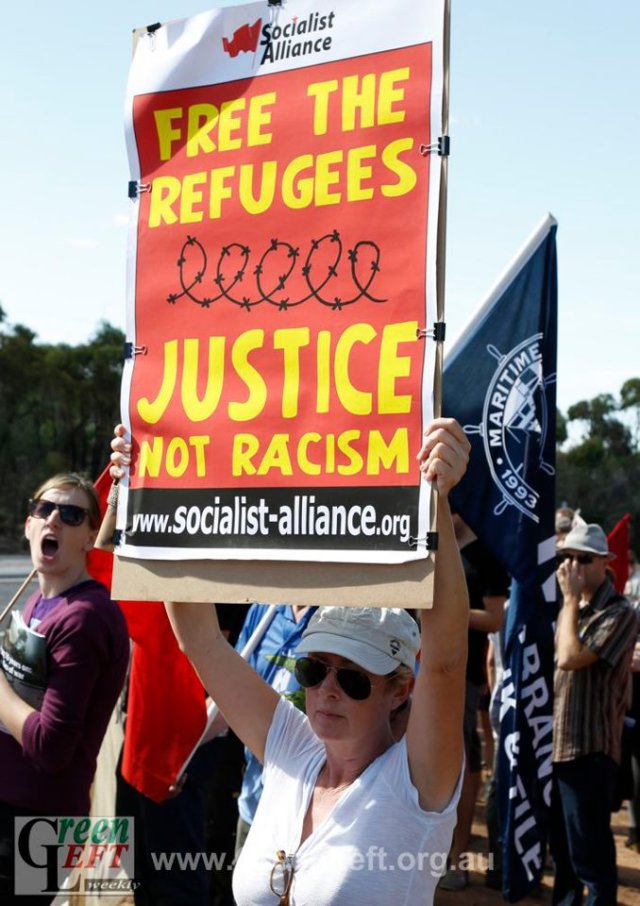
During this year alone, an estimated 128 people have drowned or vanished trying to seek asylum in Australia. By June 14, up to seven asylum boats trying to reach Christmas Island had foundered, sunk or been stranded.
This includes the boat that sank in Indonesia’s Sunda Strait in April, when Australian authorities failed to give accurate coordinates of the foundering vessel to Indonesian search and rescue. Up to 58 people drowned, 53 of whom were never retrieved.
It also includes two separate boats that were lost and stranded in January and May, which led to the probable deaths of three and two people respectively, who set out to sea on makeshift rafts to seek help and were never seen again.
In each case, Australian politicians blamed refugees — and their decisions to try to seek protection in Australia — for the disasters. So-called people smugglers sell refugees “a ticket to the bottom of the sea”, and refugees buy them. Both Labor and Liberal politicians claim too many refugees coming by boat means that some will fall through the cracks of Australia’s billion-dollar border control.
But accurate information about customs and border surveillance operations is seldom reported in the aftermath of these maritime tragedies. Much closer scrutiny is needed, as the events surrounding the latest refugee boat disaster have shown.
Over June 5-7, a boat carrying asylum seekers capsized north-west of Christmas Island. Media reports say the boat was first spotted by plane north of Christmas Island on June 5, but failed to arrive at the island and a search was not launched for it until almost 48 hours later.
The Sydney Morning Herald’s Natalie O’Brien, who has investigated several boats that have gone missing in or near Australian waters, said: “The alarm was raised with the Australian Maritime Safety Authority by Customs on Friday night — almost 12 hours after debris was reportedly spotted floating in the water from the boat, which had been reported days earlier as being ‘overdue’ on its journey from Indonesia.”
Aerial rescue eventually located 13 bodies in the water from the capsized boat. More than 55 were originally thought to be onboard, including a small number of women and children.
Refugee advocates were shocked on June 10 when customs said it would suspend efforts to retrieve the dead, leaving the 13 discovered bodies and other missing bodies in the water.
A customs and border patrol spokesperson said: “Vessels and aircraft are involved in a range of high-priority operations in the waters near Christmas Island and elsewhere.
“Our priority in these operations remains the protection of life, responding to water rescues which may prevent any further loss of life.”
Home affairs minister Jason Clare said it was an “operational decision” of border authorities and a “standard review” would be carried out of the operation.
Only a few days later, on June 11, it was confirmed that another asylum seeker boat had vanished and the search for it called off. Australian authorities said it would not continue to search for a boat suspected of carrying about 30 refugees from Sri Lanka that was headed toward the Cocos Islands.
It is near impossible to know exactly how many men, women and children have died at sea while trying to reach the apparent protection of Australian waters.
A list of drownings, compiled by SIEV-X.com’s Marg Hutton from the public record, totals up to 1376 deaths as of the June 5 disaster. Other estimates reach nearly 1800.
Labor politicians want the public to believe this is the natural cost of boarding wooden fishing vessels. Immigration minister Brendan O’Connor said the recently capsized boat was “just an awful tragedy”.
Clare said it was “another terrible reminder how dangerous these journeys are”.
Yet despite the toll of 128 dead this year, more than 10,000 arrived safely in the first four months of the year. Despite the risks, fear and terrible costs, almost 99% survived the journey.
It seems to defy the odds, but former Australian diplomat Tony Kevin says it makes sense. He says in almost all of the cases of refugees arriving safely, customs, border authorities and the navy responded on time and acted in the interests of those onboard.
But in his book Reluctant Rescuers, he says this professional system for ensuring the security of lives at sea has “been constrained and corroded by an increasingly ruthless and cynical Australian maritime border security system”.
In the task of identifying and intercepting boats on their way to Australia, Kevin says the system “sometimes declines to acknowledge and act on … intelligence when it indicates the possibility of a ‘suspected irregular entry vessel’ — a SIEV — in peril at sea.”
When considering the $1.4 billion the federal government spends on state of the art surveillance, radar, ships and planes, and intelligence gathering procedures each year, the failure to rescue a known foundering vessel or losing track of a boat cannot be explained away by saying such boat journeys are simply dangerous or inherently doomed.
The government also spends money on “disruption activities”, which frequently means destroying sea-worthy vessels in Indonesian docks and forcing refugees to board more rundown boats.
But most deaths occur closer to Australia, and that is why border control needs investigation. Why has this border control system grown so “ruthless and cynical” that it would leave known bodies in the water, denying families closure and rendering them faceless victims in the growing war against refugees?
It hasn’t grown reluctant to rescue refugees at sea in a vacuum. The government and opposition frequently go into PR spin battles over who is “tougher” or will stop the boats. The media has maintained front-page scrutiny of boats and refugee numbers and claim, as The Australian did on June 13, that Australian people are “fed up” with growing numbers.
All of this equates to huge pressure on Australian authorities patrolling the northern waters, and acts to dehumanise and vilify the innocent people willing their boat to make it to safer territory.